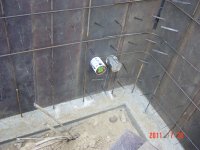Macinnis
Gold Member
I don't expect rebar to prevent cracking. I expect it to prevent movement after the cracking.
Yeah, I didn’t communicate correctly.
I got this from quite possibly the best concrete thread ever. This guy seems to really know his stuff... The Concrete Underground's Guide to Floor Slabs - The Garage Journal Board
Reinforcing - Concrete is stronger in compression than it is in tension i.e. it's harder to crush concrete than it is to pull it apart. Steel reinforcing is used to increase concrete's tensile strength. Many people apply this principle to slabs on grade and assume that steel reinforcing will prevent cracking and make the slab stronger. Unfortunately neither is really true.
The most common cause of cracking is tension from drying shrinkage. Reinforcing won't stop your slab from shrinking or prevent shrinkage cracks. In fact, reinforcing can actually increase the likelihood of cracks by restraining the slab from contracting inward as shrinkage occurs.
Reinforcing doesn't make your slab stronger because it's passive i.e. it doesn't come under load until the concrete has already cracked. Since a typical slab isn't thick enough to act like a beam, it simply 'bends' and transfers loads to the base below. If the base can't take the load, the concrete will crack.
What reinforcing will do is keep cracks - whether they are random shrinkage cracks, the cracks in the bottom of your control joints or God forbid, structural cracks - from opening up thereby maintaining the integrity of the slab. Think of steel reinforcing as crack restraint rather than crack prevention.
Is steel reinforcing absolutely necessary? Not really. For most residential slabs placed on a solid base, it's optional. If you limit shrinkage and cut timely, properly spaced control joints, the cracks below won't get very wide and aggregate interlock will keep them from displacing. Many, however will want the added insurance of reinforcing.
Slab reinforcing can be either rebar or welded wire fabric (WWF), often referred to as wire mesh. The primary advantage of rebar over WWF is that it is more rigid and thus easier to support. If using rebar, I’d suggest #3 bars at 18” o.c. supported every 3’ or #4’s at 24” o.c. supported every 4’.
If you decide to use WWF, buy sheets rather than rolls so it will lay flat. Use WWF with a heavier gauge wire such 6x6-W2.9xW2.9 that will span between supports better. Overlap the sheets 6" and stagger the runs to avoid building up too much thickness at the overlaps. You'll need to support mesh every 3' or so - don't let your finisher convince you he can pull the wire off the ground as he places.
Support your reinforcing in the middle third of the slab. There are many products available to do this such as concrete dobies, metal slab bolster or plastic chairs. Make sure your supports can stand up to finishers walking on them and that they don't poke through your vapor barrier.
If you are placing a load bearing monolithic slab, I'd recommend using rebar including a couple bars in the bottom of the thickened haunch. Floating slabs are subject to more movement and rebar will hold everything together.
Fibermesh These are fiberglass strands that are mixed in with the concrete and advertised to prevent cracking. It is often discussed as an alternative to steel reinforcing but it performs an entirely different function. Fiber minimizes early age shrinkage cracks and theoretically allows wider control joint spacing but it won't hold cracks together once they occur.

